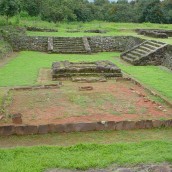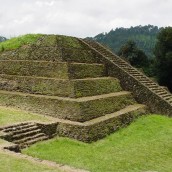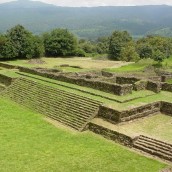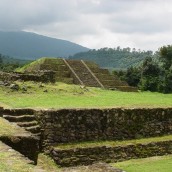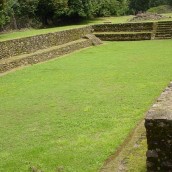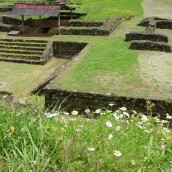I don’t know how well cute describes an archaeological site, but that’s the closest term I can find for the neat and compact ruins that are found just outside the town of Tingambato between Uruapan and Patzcuaro, Michoacan.
Besides the archaeological site of Xihuacan (also called La Soledad de Maciel or La Chole) near Petatlan and Zihuatanejo, Tingambato is the site that’s easiest to get to from Ixtapa Zihuatanejo that will give you something of the the sense of what it must be like to visit the tremendously large and extensive sites of Teotihuacan, Monte Alban, and Chichen Itza in other parts of Mexico. Except at Tingambato, the structures and dimensions seem miniaturized.
Tingambato is calculated to date from between the first and second stages of the Meso-american Classical Period (450-900 AD). Tingambato comprises two pyramid bases, a ceremonial center, a ball court, a number of what appear to be habitations or residences, platforms, and a tomb, all contained within a very small and compact area. The pyramid is easily climbable. The ball court is of a size that even I could imagine playing on it. The site itself is on a gentle slope surrounded by avocado trees and, most of the year, the greenery of the higher elevations. You don’t have to walk kilometers from the parking lot to get there. It’s perfect for a short but sweet afternoon visit, and yet in the site, you can see examples of so many of the structures and configurations that make up larger sites.
How to get there: Turn off the Uruapan-Morelia highway at the Zurumucapio Caseta (toll booth) between Uruapan and Patzcuaro. From the town of San Angel Zurumucapio, head toward Federal Highway 14. At the junction of the highway, turn toward Patzcuaro and follow to road to Santiago Tingambato. The site is on the edge of the village and anyone will be able to direct you there.
Hours: 10 a.m. to 5 p.m.
Admission, 28 pesos; Free on Sundays and holidays. Admission free for children under 13, the elderly, students, and teachers with valid ID.
- Platforms at Tingambato
- Tingambato pyramid
- View of Tingambato
- Tingambato
- Tingambato ball court
- Tingambato tomb and vista
